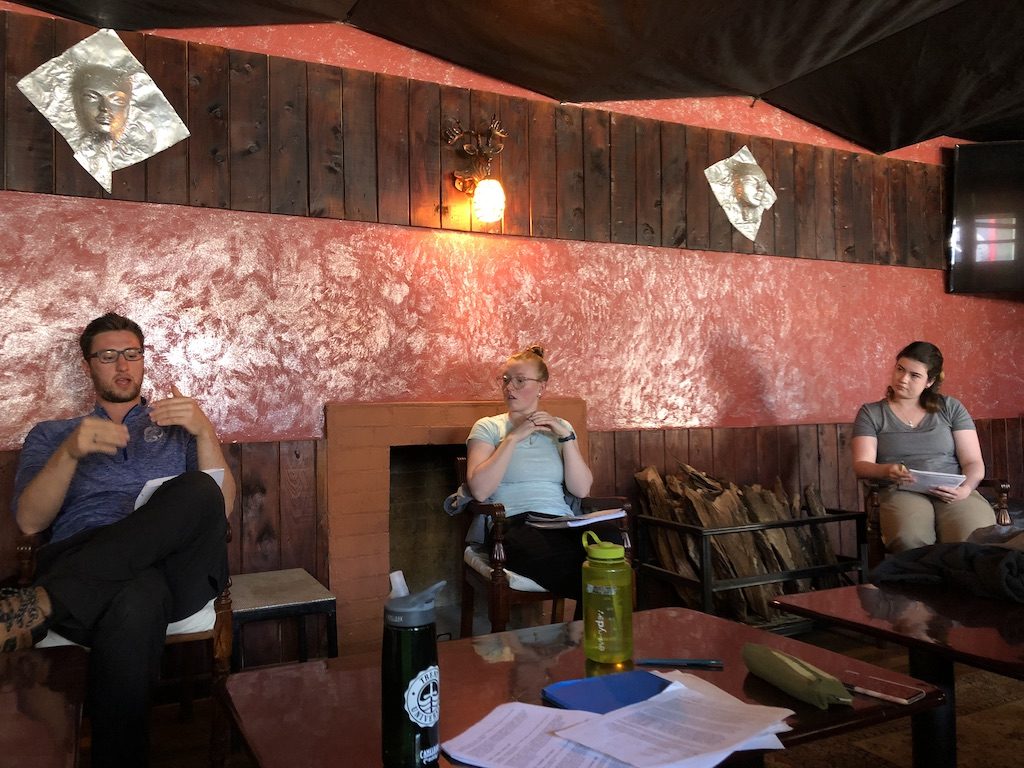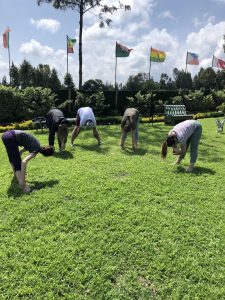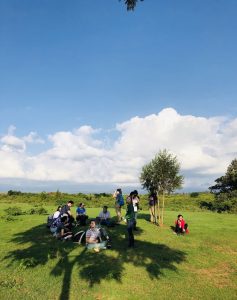Chloe, Shannon, and Arjun
Half of us woke up early in the morning for a peaceful stroll down the road to see some birds at 7 am. The rest of us managed to sleep through the horrific, ghastly, somewhat traumatizing screeches of the roosters.
Those of us who did go saw common fiscal shrikes, also known as butcher birds. This name stems from the fact that they kill their prey by impaling them upon acacia thorns to store food for later feeding, resulting in an array of corpses akin to meat hung in a butcher’s shop. We also saw some African fire finches, and an augur buzzard perched on a pole. We witnessed a puny shrike attempt to attack the buzzard, which was many times its size. The only sign that the buzzard even registered the shrike was a mere twitch of its head.
We got back from the bird walk just in time for breakfast at 8:00 am. As always, the amazing Bunduz staff prepared the meal. We had fresh omelettes made in front of us and got them hot off the pan.
At 9:30 we gathered in ‘The Dungeon’ (not an actual one as it has compy chairs) to listen to the rest of the debates and article reviews. First up was Hayden, Amber, and Silvi with a discussion on debt-for-nature swaps, wherein a nation’s debt is partially bought by a conservation organization and is forgiven if the country takes certain conservation measures. Then came a debate about traditional medicine and its impact on biodiversity by Charlotte, Elaina, and Lexly. Then finally Nell, Damian, and Kimberly had a debate on international treaties for conservation.
Then we had a break for lunch, the highlight of which was the mango pudding.
After our break it was back to the dungeon for article reviews. First off was Ying discussing a paper on latitudinal gradients in biodiversity. Next, Damien discussed a paper that sought to determine the extent of habitat fragmentation in the eastern arc mountains in East Africa. Then Shannon presented a paper on phylogenetic endemism in amphibians that sought to determine if amphibian refugia were adequately protected by conservation areas. Nell was the last to go today, and discussed a paper on the bush meat trade in the savannas of Africa. Having finished the day’s article presentations, some of us took a yoga break:
At 5 pm, we all went on another bird walk around the area and saw a hadada ibis, a grey bird with an elegant curved beak and an irredescent sheen on the outer surface of its wings, fly away furiously at our approach with a flurry of its stubby wings. We saw a black saw wing, a species of swallow identified by its striking black colouration and a deeply forked tail. We also saw a crushed chameleon on the road.
Dr. Lougheed gave a short lesson on how to properly identify birds. The lesson started in a grassy, open area, until some military guys showed up and ‘kindly’ told us that this was military land that was unmarked. And so we continued our lesson on the roadside. We learned that the shape of a bird’s bill can tell you much about the ecology of the bird. For example, if you see a bird with a wide flattened beak, it is likely that its main prey are insects.
After getting back to the camp, we worked on article presentations and did our laundry, until dinner at 7:30 pm, which included some magnificently flavoured beef stew, noodles and rice. We then sat around the fire and socialized with each other and some Kenyans we met around the fire.




Leave a Reply